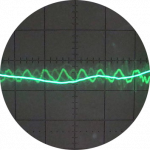Posted by: @iancalderbank@crimson I was thinking something like this, https://www.diy.com/departments/2000w-white-convector-heater/3663602433996_BQ.prd at lowest power 750w, or this https://www.diy.com/departments/400-800w-quartz-heater-2-heat-settings/5055195869661_BQ.prd at lowest power 400W. Both are dirt cheap, lightweight and small, and afterwards could be an emergency spare or whatever.
pipes - had to ask. in case it was a house with easy "just lift some floor oards" type access.
mixing - unless the flow rates are identical primary and secondary sides, then there is a guarantee of some mixing in the LLH. This is the big disadvantage of LLH. Plenty of people on this board have spent weeks trying to get balanced flow rates either side of an LLH.
cycling - (avoiding it) is all about trying to make sure all the radiator/ufh volume is engaged all of the time. which is why , the mantra is
- all zones on all the time (so you don't need zone valves)
- no bypass (so all flow must go through an emitter)
- almost all radiators on all the time (just a handful with TRV's where you really have to)
- emitters the right size for the room or close to, so by staying on all the time the room stays the right temp
- balance with lockshields (and pipe sizes) so all radiators get a "fair flow rate"
the 22mm plastic pipes you have are acting like extra lockshields. As are the small bore zone valves. making the balancing act harder.
UFH pic - can't help you personally, I've never had UFH.
Thanks Ian, found a 400/800/1200W heater that I can get here tomorrow via Amazon. Will give that a blast and report back.
Today I decided to just turn everything off. Then look at rad orders downstairs for balancing, not saying this will do anything, but as Toodles et al said balancing is always good. Seems the tall hall rad, towel rad and the larger living room rad in the poorest performing room take heat far quicker than the others, followed by one rad in the other living room, so I'll slowly try and balance those across the zone. I know the probes aren't calibrated but swapping stuff around sees a similar pattern. I'm at the point of investing in a thermal camera (sub use for rodents in outbuildings etc so not a wasteful purchase) to assist with that. Seeing as upstairs is a real fight too with the other half complaining it's too hot, I'd rather get away from the TRVs if their use further causes cycling as over time I'm sure this will all cost.
If anyone has recommendations gladly take them. I was considering one to attach to phone, but longevity questionable as currently be a lightning port one, that am sure in a couple years would want USB C - something like this perhaps (though am sure other day I saw this for £160):
https://www.amazon.co.uk/HIKMICRO-Resolution-Portable-Handheld-4%C2%B0F-752%C2%B0F/dp/B0CF28BNNX
Posted by: @iancalderbank@crimson I was thinking something like this, https://www.diy.com/departments/2000w-white-convector-heater/3663602433996_BQ.prd at lowest power 750w, or this https://www.diy.com/departments/400-800w-quartz-heater-2-heat-settings/5055195869661_BQ.prd at lowest power 400W. Both are dirt cheap, lightweight and small, and afterwards could be an emergency spare or whatever.
pipes - had to ask. in case it was a house with easy "just lift some floor oards" type access.
mixing - unless the flow rates are identical primary and secondary sides, then there is a guarantee of some mixing in the LLH. This is the big disadvantage of LLH. Plenty of people on this board have spent weeks trying to get balanced flow rates either side of an LLH.
cycling - (avoiding it) is all about trying to make sure all the radiator/ufh volume is engaged all of the time. which is why , the mantra is
- all zones on all the time (so you don't need zone valves)
- no bypass (so all flow must go through an emitter)
- almost all radiators on all the time (just a handful with TRV's where you really have to)
- emitters the right size for the room or close to, so by staying on all the time the room stays the right temp
- balance with lockshields (and pipe sizes) so all radiators get a "fair flow rate"
the 22mm plastic pipes you have are acting like extra lockshields. As are the small bore zone valves. making the balancing act harder.
UFH pic - can't help you personally, I've never had UFH.
Alternatively, if you have the time, you could use your present 2kW heater in a timed manner. On for 5 minutes off for 5 minutes would provide an overall supply of 1kW of energy. On for 1 minute off for 4 minutes would supply 400W etc.
Posted by: @derek-mPosted by: @iancalderbank@crimson I was thinking something like this, https://www.diy.com/departments/2000w-white-convector-heater/3663602433996_BQ.prd at lowest power 750w, or this https://www.diy.com/departments/400-800w-quartz-heater-2-heat-settings/5055195869661_BQ.prd at lowest power 400W. Both are dirt cheap, lightweight and small, and afterwards could be an emergency spare or whatever.
pipes - had to ask. in case it was a house with easy "just lift some floor oards" type access.
mixing - unless the flow rates are identical primary and secondary sides, then there is a guarantee of some mixing in the LLH. This is the big disadvantage of LLH. Plenty of people on this board have spent weeks trying to get balanced flow rates either side of an LLH.
cycling - (avoiding it) is all about trying to make sure all the radiator/ufh volume is engaged all of the time. which is why , the mantra is
- all zones on all the time (so you don't need zone valves)
- no bypass (so all flow must go through an emitter)
- almost all radiators on all the time (just a handful with TRV's where you really have to)
- emitters the right size for the room or close to, so by staying on all the time the room stays the right temp
- balance with lockshields (and pipe sizes) so all radiators get a "fair flow rate"
the 22mm plastic pipes you have are acting like extra lockshields. As are the small bore zone valves. making the balancing act harder.
UFH pic - can't help you personally, I've never had UFH.
Alternatively, if you have the time, you could use your present 2kW heater in a timed manner. On for 5 minutes off for 5 minutes would provide an overall supply of 1kW of energy. On for 1 minute off for 4 minutes would supply 400W etc.
thanks Derek, will give that a go. I presume do this when the room kind of caps temp with the ASHP And the push to 21c and record approx kw added?
If my understanding is correct, Ian is suggesting using an additional heat source to estimate how much additional thermal energy is required to achieve the desired room temperature.
Using a 1 minute on period and varying the off period should hopefully allow a reasonably accurate assessment to be made.
Posted by: @derek-mIf my understanding is correct, Ian is suggesting using an additional heat source to estimate how much additional thermal energy is required to achieve the desired room temperature.
Using a 1 minute on period and varying the off period should hopefully allow a reasonably accurate assessment to be made.
exactly that. If you find that with the ASHP heating on, and a 400W of direct electric heat as well (whether that is one 400w heater on all the time, or a bigger one being switched on and off on a timer, doesn't matter), the downstairs reaches the required temperature, that then tells you that the ASHP heating is 400 watts short of what you need in that room. Which should help a lot with deciding what needs doing to the radiators. I am not suggesting to run this as a forever solution.
My octopus signup link https://share.octopus.energy/ebony-deer-230
210m2 house, Samsung 16kw Gen6 ASHP Self installed: Single circulation loop , PWM modulating pump.
My public ASHP stats: https://heatpumpmonitor.org/system/view?id=45
11.9kWp of PV
41kWh of Battery storage (3x Powerwall 2)
2x BEVs
Posted by: @iancalderbankPosted by: @derek-mIf my understanding is correct, Ian is suggesting using an additional heat source to estimate how much additional thermal energy is required to achieve the desired room temperature.
Using a 1 minute on period and varying the off period should hopefully allow a reasonably accurate assessment to be made.
exactly that. If you find that with the ASHP heating on, and a 400W of direct electric heat as well (whether that is one 400w heater on all the time, or a bigger one being switched on and off on a timer, doesn't matter), the downstairs reaches the required temperature, that then tells you that the ASHP heating is 400 watts short of what you need in that room. Which should help a lot with deciding what needs doing to the radiators. I am not suggesting to run this as a forever solution.
On no course not permanent, just mean the point of top up, when the worse living room peaks today I’ll give this a whirl. Will also be good to see what 21C feels like. Somewhat a bizarre statement but we’ve seen with underfloor 20-20.5 is enough, bedrooms even during day 21C can feel bit too much. I guess this depends on the space, but I’ll aim for 21C as that’s what the system is designed for.
@crimson IR stuff - I have a basic IR spot gun which isn't bad for not much money and is quick and easy. But I eventually I got a Seek Thermal for my phone (android so USB'c) that is really good. There are quite a few alternatives, there may be better, read some reviews...
My octopus signup link https://share.octopus.energy/ebony-deer-230
210m2 house, Samsung 16kw Gen6 ASHP Self installed: Single circulation loop , PWM modulating pump.
My public ASHP stats: https://heatpumpmonitor.org/system/view?id=45
11.9kWp of PV
41kWh of Battery storage (3x Powerwall 2)
2x BEVs
Posted by: @iancalderbank@crimson IR stuff - I have a basic IR spot gun which isn't bad for not much money and is quick and easy. But I eventually I got a Seek Thermal for my phone (android so USB'c) that is really good. There are quite a few alternatives, there may be better, read some reviews...
thanks @iancalderbank, I’ll have a peruse.
Builder sent me a message from plumbers stating internal 32mm duo pipe with 1” irons to 28mm copper piping. I think somewhere along the lines lost in communication that it was the main plastic runs in ceilings and smaller pipes to copper to rads that was the concern. Have re-asked.
One thing I’ve realised tonight. My rads have Drayton TRV4s. After watching some lockshield videos as was finding audibly there’s very little control in the lockshield (not quite Shogun level of entertainment), saw a comment saying with the Drayton TRV4 sets the balancing should be done on the TRV side using a special Drayton key. I’ll check tomorrow that all of the rads are in the max position in regards to that, and will get said key from Screwfix.
Posted by: @derek-mIf you haven't already seen this video you may find it of use.
thabks Derek it was actually that video that pointed me in the direction of Drayton TRV balancing as a comment in there observed little control with the lock shield that comes with the Drayton TRV4.
im going to have a look round the house under the TRVs as I’ve noticed and not sure it’s clear in my photo, that the problem room, the worse rad shows a number 3 in the centre of the TRV. Whereas checking in one of our performant bedrooms that shows 4s. I don’t know if that’s just something that changes as water passes through or a preset, finding it hard to see documentation referring to that part.
I’ll note down this across all rads with them on and see if any have different settings on the outer dial as well.
Heavily doubt plumbers did anything intentional with these as day ground floor rads were installed was a huge rush as they lost time due to having pipe centres wrong
- 26 Forums
- 2,364 Topics
- 53.6 K Posts
- 191 Online
- 6,029 Members
Join Us!
Worth Watching
Latest Posts
-

How long will your energy contract last?
Some heat pump tariffs don’t run as long as a heat pu...
By Toodles , 10 hours ago
-

@morgan They are unsupervised these days, can’t get the...
By Toodles , 10 hours ago
-
-
RE: Octopus Cosy Heat Pump Owners & Discussion Thread
@kevh it's worth remembering that many lsvs only actual...
By JamesPa , 1 day ago
-

RE: Setback savings - fact or fiction?
Exactly. We only need to compare conditions, to decide ...
By cathodeRay , 2 days ago
-
RE: Balancing financial efficiency and comfort using the Octopus Cosy tariff
I found because I have very low heat loss I can set bac...
By RadWhisperer , 2 days ago
-
RE: Need Help Optimising My Rushed ECO4 Install: 12kW Bosch Heat Pump
Welcome @mickamills We too have an oversized 12kW Sa...
By Old_Scientist , 2 days ago
-
RE: My Powerwall 3 Consumes 3-4 kWh/Day in Self-Consumption: Is This Normal?
@caron I can confirm that the power usage of the PW3 is...
By Old_Scientist , 2 days ago
-
RE: Speedcomfort radiator fans
Thats true, but having tried (and succeeded) in constru...
By JamesPa , 2 days ago
-
RE: Solis S6-EH1P8K-L-PLUS – Why I Chose It and What I’ve Learned So Far
@bash brilliant, thanks for the feedback
By energy9165 , 2 days ago
-

RE: Heat Pump Heats the House… But It’s Not Cosy. Emitter Changes or System Tweak?
@alastair There I was, feeling grumpy, he said “Cheer u...
By Toodles , 2 days ago
-
RE: Grant Aerona: Is there a setting to keep the 2-port valve open during pump blockade
Depends on OAT. Mine cycles at OAT>10 and of course...
By JamesPa , 2 days ago
-
RE: New Fogstar 15.5kWh upright solution
@transparent My conclusion is as you have noted, tha...
By Bash , 2 days ago
-
RE: Mitsubishi Ecodan R290 10kW performance
And to you too. Wishing you a very enjoyable festive s...
By Sheriff Fatman , 2 days ago
-

RE: External pipework insulation
They do? But that isn't apparent from the photos we'r...
By Transparent , 3 days ago
-

RE: Say hello and introduce yourself
@velcro welcome to the forums. Please feel free start a...
By Mars , 3 days ago
-
Daikin EDLA11D3V3 DHW Settings
I have a newly installed EDLA11D3V3 which I'm still get...
By Velcro , 3 days ago
-
RE: Midea ASHP – how to set weather compensation
@curlykatie did you get sorted with this?
By MickaMills , 3 days ago
-
RE: MyVaillant Connect Regular Disconnect
Thanks. Yes, if the time is consistently 11pm every nig...
By buckwem , 4 days ago





